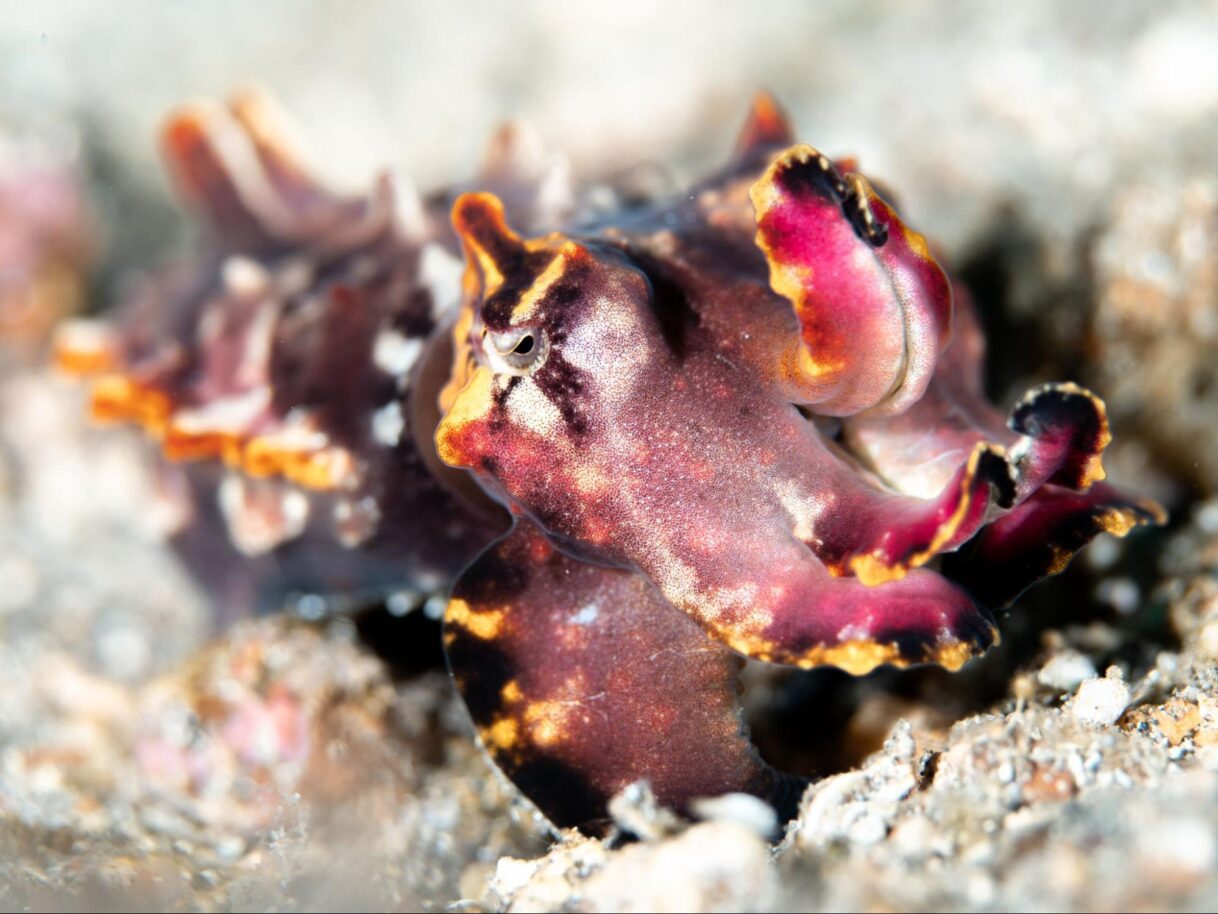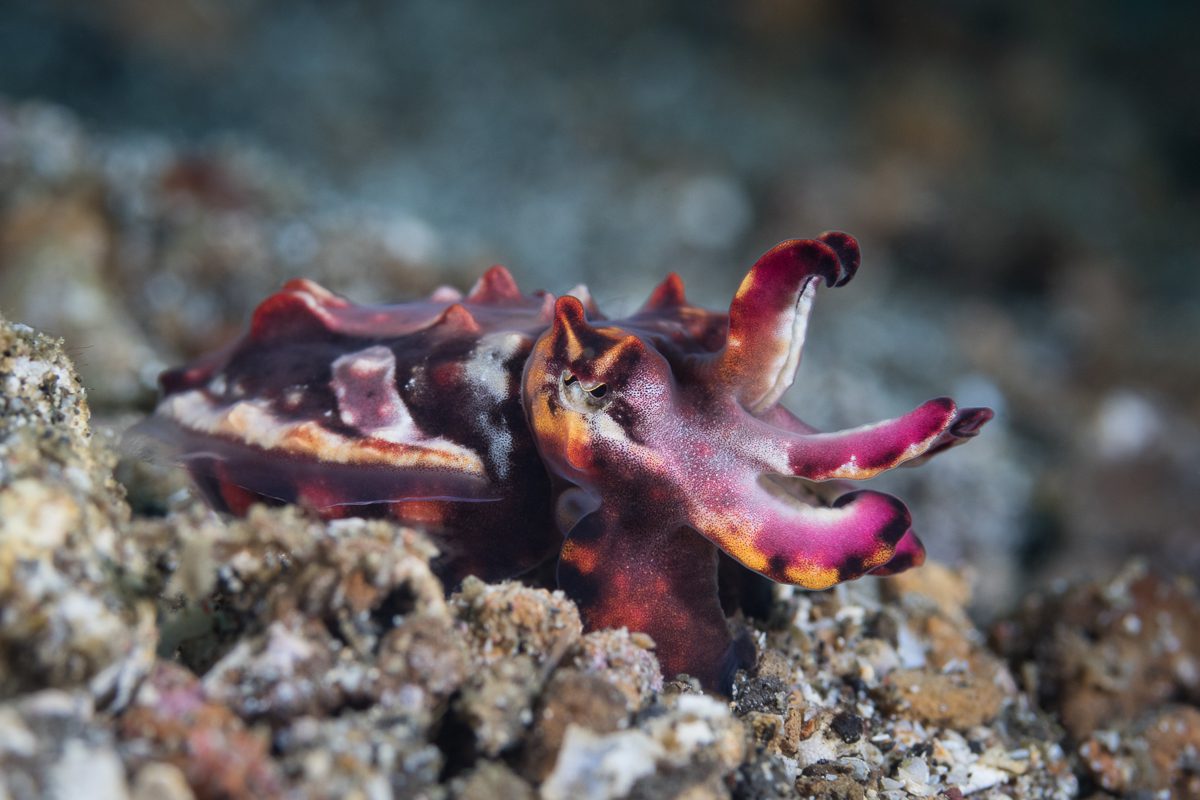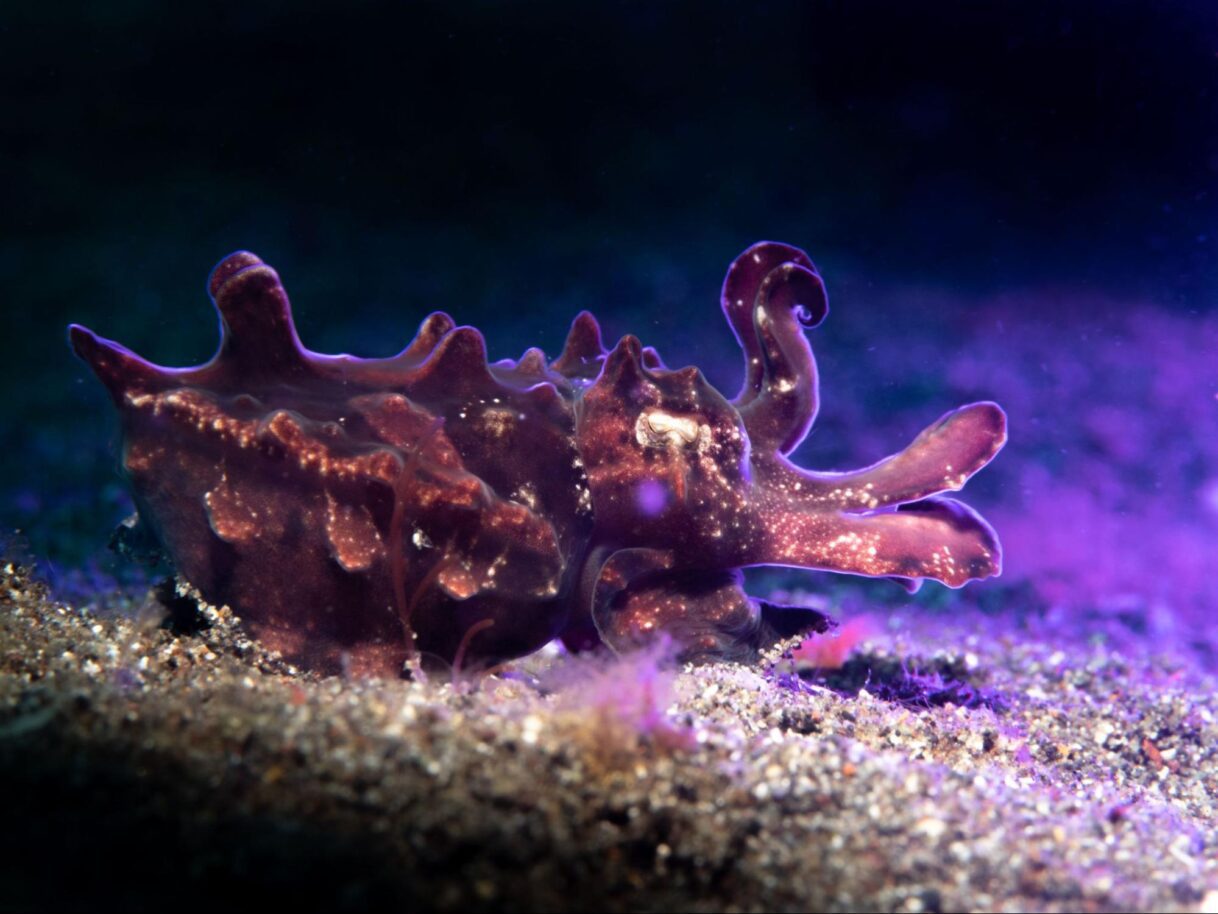The Flamboyant Cuttlefish (Metasepia pfefferi)

The aptly named flamboyant cuttlefish is one of the highlights of diving in the Lembeh Strait – they are on the wish lists of many divers visiting Lembeh Resort. These colorful little critters are a treat for underwater photographers and they are quite unique when compared to other species of cuttlefish too.
Appearance and Colors
This is one of the smaller species of cuttlefish and they only grow up to around 8cm. When unthreatened they are anything but flamboyant, their coloration varies from white to a dull purple-brown colour.

The unique colors of the flamboyant cuttlefish when flashing
The flamboyant cuttlefish flashes its impressive colors when it is under threat and they serve as a warning to any possible predators that their flesh is toxic. They can display a spectrum of colors from bright reds and pinks to vivid purples and almost fluorescent yellow and orange around their skirts. The color flashes are often observed in tandem with the front tentacles being stretched upwards or forwards as another warning and perhaps as a way to make themselves appear bigger. Younger flamboyant cuttlefish generally prove to be more colorful than older individuals.
Movement and Habitat
Aside from their colors, another characteristic that makes the flamboyant unique among cuttlefish is the way in which it moves. Unlike other cuttlefish species, flamboyants rarely swim, and instead, they use their lower pair of ‘arms’ and small, paired flaps on the lower body to walk around on the sea floor.
They are found in depth ranges from 3 – 80 meters, are relatively easy to approach, and will allow divers to get up close before they show signs of feeling threatened. It’s likely that their bold colors are such an effective defense that they make them less shy than other cuttlefish species. Due to their habit of walking, rather than swimming, they can be observed by divers for long periods.
Hunting and Feeding

Flamboyant cuttlefish hunting
Whilst these cuttlefish are small and colorful they are definitely not to be underestimated; they hunt by day for smaller crustaceans and fish that dwell under the surface of the sand. Once they have identified a target, their front pair of tentacles shoot forwards with impressive speed and seize the innocent and unsuspecting prey.
Dive Sites & Spotting Flamboyant Cuttlefish in Lembeh
Flamboyant cuttlefish are seen at a number of dive locations in the Lembeh Strait, most notably they are found on Lembeh’s sandy slopes and coral rubble sites. Due to their non-distinct colors when unthreatened they can be surprisingly well hidden in plain sight.
The best way to spot them and to identify them from other cuttlefish species is by their size and method of movement – they are also commonly seen in pairs but individuals are not unusual. Some of the best dive sites in Lembeh for flamboyant cuttlefish include Air Prang, Jahir, ROJOS, Critter Hunt, and Air Bajo.
Flamboyant Cuttlefish Underwater Photography

This flamboyant cuttlefish was captured with artistic lighting
When capturing images of flamboyant cuttlefish care has to be taken not to stress the animal. Flamboyants should not be deliberately agitated in order to make them flash their colors. Being approached by a camera lens that resembles a giant eye will usually have this effect regardless. Due to their way of walking along the bottom, it’s possible to spend a reasonable period with an individual because unlike other cuttlefish species they won’t jet propel away. Here are some additional tips for photographers.
8 Tips for Photographing Flamboyant Cuttlefish in Lembeh
- Stay low down and close to the bottom to appear smaller and minimize stress.
- Try to avoid stirring up the sandy bottom to minimize backscatter
- The closer you are to the critter the less ‘noise’ will appear in your image.
- Shooting from a 1 or 2 o’clock angle will give a nice composition with the tentacles in the shot, head, body, and back end.
- For the wellbeing of the critter, when shooting with lights or strobes, be aware of the passing of time and limit your shots – especially if there are other photographers in your group who would also like to shoot.
- If you happen to find a pair of flamboyant cuttlefish, avoid positioning yourself between them and allow them to stay together.
- Make use of our private and photography guide services. You won’t have to wait for others to shoot and our photography guides are extremely well-versed in positioning lights and carrying accessories – saving you time and air underwater!
- Visit our Photo Pro and Photo Center Assistants in our Backscatter Authorized Photo Center. They are more than happy to give advice about lighting, techniques, and editing. They also have a selection of photography accessories available both to purchase and to rent so you can try out new techniques.
Capturing Critters in Lembeh Underwater Videography & Photography Workshop
Do you want to take your photography to the next level? Our 2024 Capturing Critters in Lembeh Workshop is now scheduled and we are taking reservations! The 2024 workshop will once again be hosted by three visiting photo pros, and we are looking forward to welcoming back Saeed Rashid and Alex Tattersall, as well as this year’s Ocean Photographer of the Year winner Nicolas Remy!
Explore Lembeh Resort rates and book your extraordinary stay with us today! Contact us now for more information.



